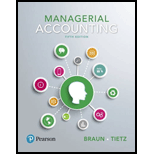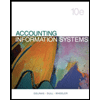
(Learning Objective 1) Which of the following management responsibilities often involves evaluating the results of operations against the budget?
- a. Planning
- b. Directing
- c. Controlling
- d. None of the above
To identify: The activity which involves evaluating the results against the budget
Answer to Problem 1QC
Option c. Controlling is the management responsibility which involves evaluating the results of operations against the budget.
Explanation of Solution
Management responsibilities: The management of the organization is responsible for various functions like planning, directing, controlling, and decision making in order to achieve the success. A manager implements the established standards, thinks of various alternatives in order to meet the defined standards or budgets and identify the factors leading towards undesirable results.
a.
Planning: Planning is the first and foremost function performed by the manager which is concerned with defining objectives and goals of the particular entity and the manner in which these goals can be achieved. While planning, the management sets particular standards in the form of budgets. Budgets are defined after a due observation of the financial structure of the organization. However, planning deals with the formation of budgets but it does not involve comparing the budgets with actual results. Thus, this option is incorrect.
b.
Directing: Directing is the activity which includes supervising the daily operations of the business entity. Directing involves taking small decisions which are concerned with sales or products such as the deciding the promotional plan for a particular product in order to boost its sales. Thus, this option is not correct.
c.
Controlling: Controlling is the responsibility of management which deals with the revaluation of plans and actions by comparing the actual results obtained and the standards set against them. Controlling is a kind of feedback which determines to what level an entity has been successful in its operations. Thus controlling is the responsibility of the management which involves evaluating the result of operations against the budget. Therefore, the option is correct.
d.
None of the above: The management activity which involves comparing the budgets and actual results is controlling. Thus, this option is incorrect.
Want to see more full solutions like this?
Chapter 1 Solutions
Managerial Accounting (5th Edition)
- HELParrow_forwardI am looking for the correct answer to this financial accounting problem using valid accounting standards.arrow_forwardThe predetermined overhead rate is $18.50 per direct labor hour. Job 678 required 420 total direct labor hours to complete, of which 280 hours were incurred during the current month. How much overhead should be applied to Job 678 during the current month?arrow_forward
- Principles of Accounting Volume 2AccountingISBN:9781947172609Author:OpenStaxPublisher:OpenStax College
 Pkg Acc Infor Systems MS VISIO CDFinanceISBN:9781133935940Author:Ulric J. GelinasPublisher:CENGAGE L
Pkg Acc Infor Systems MS VISIO CDFinanceISBN:9781133935940Author:Ulric J. GelinasPublisher:CENGAGE L Cornerstones of Cost Management (Cornerstones Ser...AccountingISBN:9781305970663Author:Don R. Hansen, Maryanne M. MowenPublisher:Cengage Learning
Cornerstones of Cost Management (Cornerstones Ser...AccountingISBN:9781305970663Author:Don R. Hansen, Maryanne M. MowenPublisher:Cengage Learning


